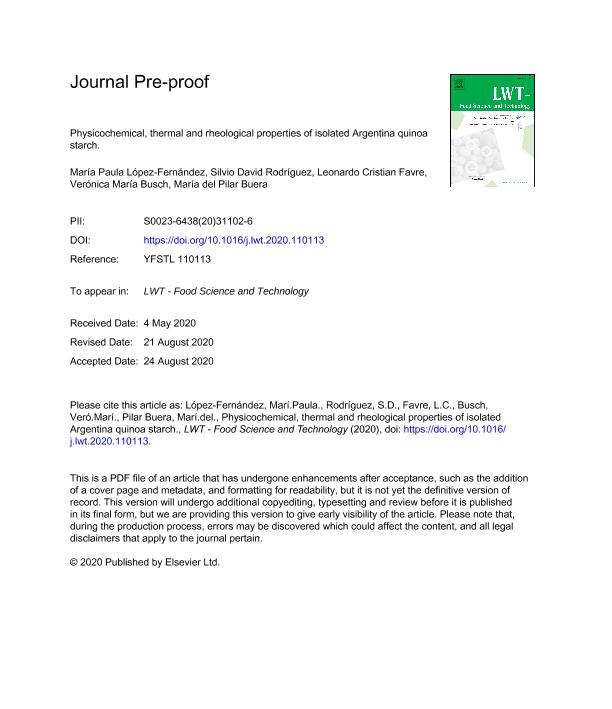Artículo
Physicochemical, thermal and rheological properties of isolated Argentina quinoa starch
Lopez Fernandez, Maria Paula ; Rodríguez, Silvio David
; Rodríguez, Silvio David ; Favre, Leonardo Cristian
; Favre, Leonardo Cristian ; Busch, Verónica María
; Busch, Verónica María ; Buera, Maria del Pilar
; Buera, Maria del Pilar
 ; Rodríguez, Silvio David
; Rodríguez, Silvio David ; Favre, Leonardo Cristian
; Favre, Leonardo Cristian ; Busch, Verónica María
; Busch, Verónica María ; Buera, Maria del Pilar
; Buera, Maria del Pilar
Fecha de publicación:
08/2020
Editorial:
Elsevier Science
Revista:
LWT - Food Science and Technology
ISSN:
0023-6438
Idioma:
Inglés
Tipo de recurso:
Artículo publicado
Clasificación temática:
Resumen
The aim of the present study was to evaluate the physicochemical, thermal and pasting properties of the starch of six quinoa genotypes native to the northwest of Argentina. The genotypes belonging to two genotype groups, highlands and dry valley, were grown in Jujuy, Argentina. Significant differences among genotypes were observed (P < 0.05) in amylose content, swelling power, water-binding capacity, thermal and pasting properties. In the different genotypes, the starch was characterized by a typical A-type X-ray diffraction pattern, with relative crystallinity ranging between 26.1 and 28.5%. Granule-bound starch synthase (GBSS), which is the single enzyme responsible for amylose biosynthesis, was also identified, with the 67- and 58-kDa quinoa polypeptides corresponding to the full-length and mature GBSS proteins. Studies of the pasting properties showed that the starch of the genotypes from the highlands had lower peak viscosity and lower breakdown parameter than that of the genotypes from the dry valleys. The results showed that the genotypic background and the environment influence the pasting curves. The novel findings discussed in this study constitute a starting point for research focusing on incorporating innovative technologies in the food and biomaterials industry.
Palabras clave:
AMYLOSE
,
DSC
,
GENOTYPE
,
PSEUDOCEREALS
,
QUINOA
,
STARCH
Archivos asociados
Licencia
Identificadores
Colecciones
Articulos (ICYTESAS)
Articulos de INSTITUTO DE INVESTIGACION DE LA CADENA LACTEA
Articulos de INSTITUTO DE INVESTIGACION DE LA CADENA LACTEA
Articulos(IBBEA)
Articulos de INSTITUTO DE BIODIVERSIDAD Y BIOLOGIA EXPERIMENTAL Y APLICADA
Articulos de INSTITUTO DE BIODIVERSIDAD Y BIOLOGIA EXPERIMENTAL Y APLICADA
Articulos(ITAPROQ)
Articulos de INSTITUTO DE TECNOLOGIA DE ALIMENTOS Y PROCESOS QUIMICOS
Articulos de INSTITUTO DE TECNOLOGIA DE ALIMENTOS Y PROCESOS QUIMICOS
Citación
Lopez Fernandez, Maria Paula; Rodríguez, Silvio David; Favre, Leonardo Cristian; Busch, Verónica María; Buera, Maria del Pilar; Physicochemical, thermal and rheological properties of isolated Argentina quinoa starch; Elsevier Science; LWT - Food Science and Technology; 135; 8-2020; 1-9
Compartir
Altmétricas



